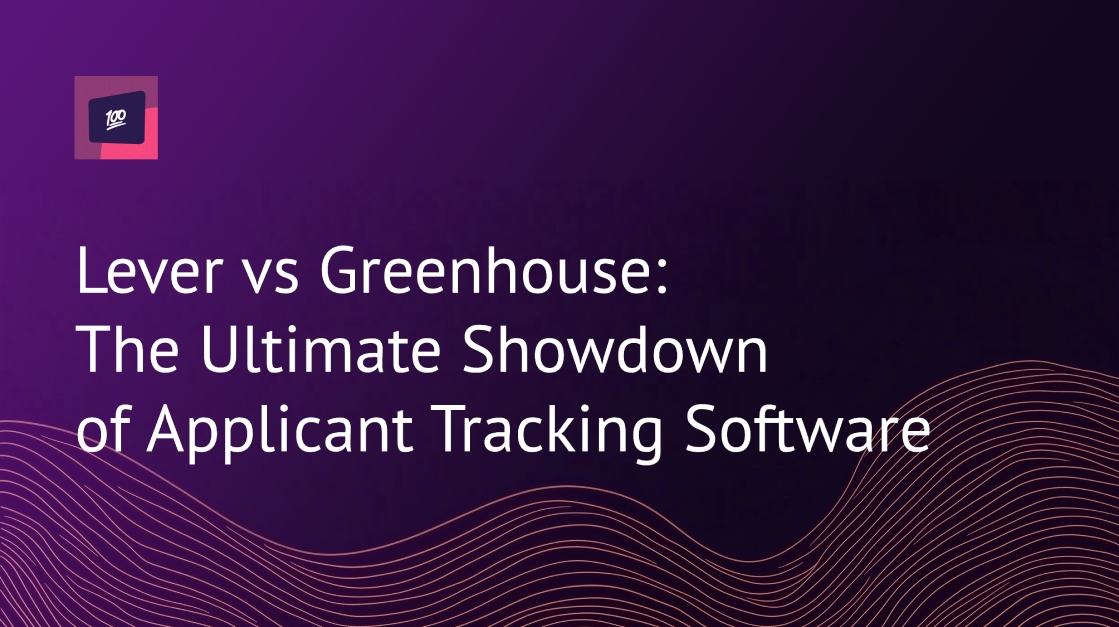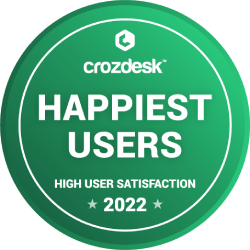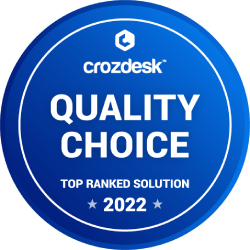Lever vs Greenhouse: The Ultimate Showdown of Applicant Tracking Software
| Lever | Greenhouse | 100Hires | |
|---|---|---|---|
| Free trial | |||
| Month-to-month pricing plans | |||
| Applicant tracking | |||
| Job posting and advertising | |||
| Customizable careers page | |||
| Sourcing Chrome extension | |||
| Collaboration | |||
| Candidate feedback | |||
| Custom fields | |||
| Gmail integration | |||
| Microsoft Outlook integration | |||
| GDPR | |||
| Email templates | |||
| Interview scheduling | |||
| Zoom integration | |||
| Hiring workflows | |||
| Unlimited users | |||
| Automated actions | |||
| Job description templates | |||
| Job mailbox |

Right from the start, investors and business analysts predicted Greenhouse to become the next big thing. The company raised $2.7M in a seed round and more than $100M during the next four rounds of investments. Their mission has always been to help every company be good at hiring. They also put a great emphasis on inclusivity and diversity which is an absolute must for every modern business.
And what about Lever? The tool also appeared as an attempt to disrupt the market of applicant tracking systems. Old solutions were heavy and nearly impossible to run, so the founders behind Lever decided to rethink the whole approach towards hiring. When it comes to diversity, they put money where their mouth is as well. Lever's workforce is more than 50% female and 40% non-white.
the best candidates faster



But we’re not here to judge them by their hiring philosophies and approaches toward software development. We’re here to solve the never-ending Lever vs Greenhouse question. So, which applicant tracking system is better? Let’s delve right in.
Table of contents:
Lever vs Greenhouse: Overall Impression
Lever vs Greenhouse: TL;DR
Both Lever and Greenhouse are rich in features covering all applicant tracking and recruiting processes. However, Greenhouse is way more enterprise-oriented and beats the competition by its advanced functionality and the number of integrations. For instance, Lever lacks some onboarding or background screening features that Greenhouse does offer.
On the other hand, Lever costs less for small businesses and becomes more expensive as your number of employees grows. At the same time, Greenhouse’s pricing system is very adjustable and flexible for bigger enterprises.
If you’re looking for something equally powerful yet more affordable, 100Hires can be a great alternative to both tools. It offers all the necessary features for full life cycle recruiting while costing several times less. The free subscription plan is also available.
Lever vs Greenhouse: Features
Since both tools are considered quite accomplished and famous in their categories, comparing Lever vs Greenhouse can take days. It’s just that they have so many obvious and unconventional recruiting features that one can easily get lost. What you see below is a quick analysis of both tools’ core functionality:
Lever features
Lever is an end-to-end recruiting system offering all the necessary features for a full life cycle recruiting process. They divide their toolset into three key components:
- Lever Hire — for sourcing, interviewing, and hiring job candidates
- Lever Nurture — for sourcing automation and personalized outreach
- Lever Analytics — for granular reports on every aspect and stage of the hiring process
However, this division is rather artificial since Lever comes as an all-in-one pack of features from all three products — the Lever Talent Suite. Even with the basic ‘Starter’ subscription plan, you get to create a custom career site and recruiting pipeline as well as monitor real-time reports. Basically, you can find, nurture, interview, and hire the best candidates, and that is the most important thing.
With the help of the Lever Chrome extension, recruiters can find candidates’ contact information and reach out to them on the go. The built-in calendar will come in handy for scheduling interviews and syncing all upcoming activities.
The more advanced ‘Professional’ subscription plan stands out because of its third-party integrations including LinkedIn Recruiting and Slack as well as the ability to export your data in a CSV file. HR reps will enjoy the electronic signatures feature that allows businesses to tie up any deal in a few clicks. The ‘Enterprise’ subscription offers some advanced features for big corporations like API and security enhancements.
Greenhouse features
By their own definition, Greenhouse is an applicant tracking and recruiting system. And it’s extremely versatile, for that matter. The company’s website lists two major use cases for the solution:
- Recruiting — for preparing, sourcing, screening, interviewing, and hiring the best job candidates
- Onboarding — for welcoming new hires after they accept the offer.
The Greenhouse Recruiting toolset offers three subscription options. The ‘Essential’ pack includes all basic features for multi-channel sourcing and sending bulk email sequences. Recruiters can also screen candidates by examining their experience and doing background checks.
In addition to all these standard recruiting features, The Greenhouse CRM is included in all three subscription plans. It serves as the ultimate stop for all applicants’ data. You can add new prospects from various channels — e.g. export them from emails, spreadsheets, or LinkedIn RSC. Recruiters can then manage those contacts by assigning tags, responsible people, specifying sources, etc.
If you’re going to use the rich choice of onboarding features, you will have to purchase the Greenhouse Onboarding as a separate solution. It will allow you to create a unique employee orientation workflow and monitor its execution as well as automate task assignments, reminders, and notifications.
My overall impression is that Greenhouse is a well-developed tool with an extremely extensive set of features, numerous integrations, and out-of-the-box add-ons. For instance, they offer 340+ third-party integrations as of the moment including LinkedIn, Hire, BambooHR, Codility, etc.
The company places a particular emphasis on the tool’s features for diversity, equity, and inclusion. HR experts will see various timely popups reminding them to try and reduce bias throughout all hiring stages. All managers will have to fill in evaluation forms and provide explanations for controversial ratings.
Lever vs Greenhouse: Pricing
It’s next to impossible to evaluate Lever vs Greenhouse prices as none of the tools is revealing them. Anyone who will take the trouble can book a demo with the companies’ sales reps to demand the actual cost and get a custom quote.
However, some third-party websites took up the running and surveyed companies’ existing customers to discover how much they actually pay for their ATS tools.
From what we could discover, Lever’s pricing system is based on a cost per employee. So, your spending might vary from $3,000 to $125,000 per year. Greenhouse has less affordable options for small businesses with its pricing starting from around $6,000 (for a couple of dozen employees) to $25,000 per year. However, these numbers are even not remotely final. It’s a known fact that Greenhouse targets huge corporations and has clients with 10,000+ employees. So it’s fair to assume their upper limit of the pricing range exceeds $100K per year.
Lever vs Greenhouse: Reviews
Greenhouse scores 4.5 / 5 stars based on 519 reviews. Almost 400 G2 users have rated the tool with 4.3 / 5 stars. People in general leave numerous satisfied comments regarding the tool’s customization options, versatility, and friendly interface. However, some people note that the company’s pricing system can be too much for smaller businesses.
Lever is not far behind with its 4.5 / 5 stars and 434 reviews on Capterra. Even though the tool has collected more than 1K reviews on G2, its G2 rating is only 4.1 / 5. Users praise the solution for its clean and intuitive interface backed by a strong onboarding experience. But even though the overall impression of the tool is rather nice, customers complain about the lack of customization and some minor features.
All in all, both tools have managed to attract many loyal customers and brand advocates. They’re reliable, rich in features, and don’t have too many glitches, so you can barely see any negative feedback about any of them. Their rather high prices can be the only deal breakers.
Lever vs Greenhouse: Overall Impression
It’s quite obvious even after quick research that Greenhouse beats Lever by the number of recruiting features and third-party integrations. Lever lacks employee onboarding features as well as a background screening.
Greenhouse is also more suitable for mid-size businesses and huge corporations in terms of pricing. Its subscription fees are becoming more flexible for companies with 500+ employees. Lever, on the other hand, offers competitive subscription plans for smaller businesses.
All in all, both tools are very well-developed and offer the most extensive set of tools for full life cycle recruiting. If your goal is to simply find the best candidate for a job, you’ll be able to do that with either of the two. However, if you’re not willing to spend thousands of dollars on this purpose, it might be a good idea to look for more affordable alternatives like 100Hires.
100Hires is an all-in-one applicant tracking system that allows small and midsize businesses to manage all their recruiting processes in one place. You will have access to a detailed CRM with all the necessary information about job applicants. Move them between different pipeline stages, set up email campaigns, and parse emails right from your Gmail account. The pricing is 100% transparent with the basic subscription being available for free. Sign up now and take your recruiting game to the next level.
the best candidates faster




